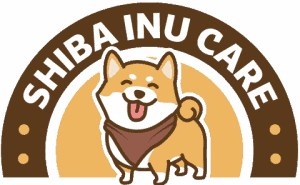This post contains affiliate links.
Finding a harness that fit my Shiba Inu was a bigger challenge than I expected when I first got her. And most did little to help with her rampant leash-pulling.
Most adult Shiba Inus fit comfortably in medium-sized harnesses, extra small for Shiba Inu puppies. If you have the option it’s best to grab a front-attaching harness. They dramatically reduce your pet’s leash pulling, helping you maintain control over them.
Thankfully with time I was able to find the right type of harness for both of us. One where I didn’t have to worry about her dragging my around like a furry bowling ball. I’ve shared everything I’ve been able to learn below.
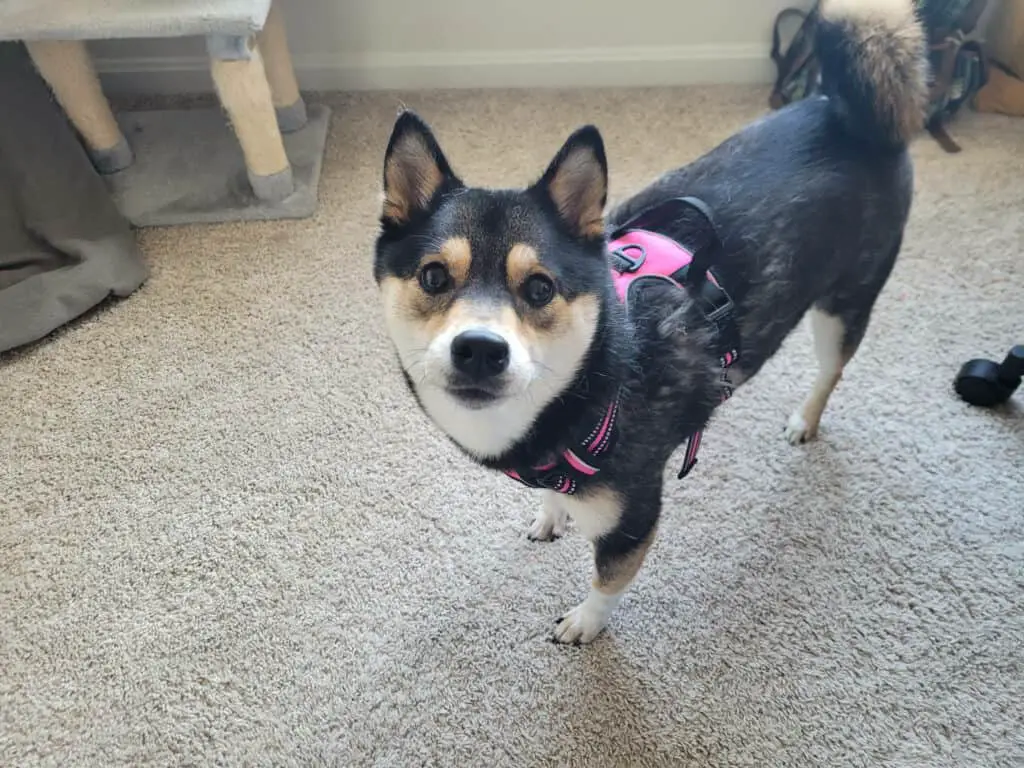
Your Shiba Should Be Using A Harness Instead Of A Collar
While Shiba Inus are known for being rugged dogs that unfortunately isn’t the case for their eyes. Glaucoma and other eye-related health issues are common for this breed, so it’s best to avoid adding unnecessary stress and pressure to their eyes if you can avoid it.
Collars when paired with leash pulling, cause excess strain and pressure on a Shiba’s neck, which over time builds pressure around their eyes. Increasing the likelihood of your Shiba Inu developing an eye-related injury or disability. Harnesses will also make your Shiba Inu easier to control, making them easier to leash train.
What Types Of Dog Harnesses Are There?
Dog harnesses come in two distinct flavors based on how a leash attaches to them, either on the front or back. Both have their unique pros and cons, so allow me to explain the differences.
Front Attached Dog Harness
Forward-clipping harness provides you more control over your Shiba Inu, helping you manage any bad or aggressive behaviors. Harnesses that attach on the front also help with leash pulling, causing your Shiba to turn towards you instead of dragging you with them.
This help in guiding your pet back towards you and also prevents leash pulling and has earned them the nickname “no pull” harness.
Front-attaching harnesses do, however have a few downsides. Your Shiba is more likely to get caught and tangled in their leash, especially if it’s loose instead of retractable, and they are a bit more difficult to put on your pet. So you may struggle to put one on your Shiba, at least at the beginning.
Back Attached Dog Harness
Back-attaching harnesses are easier to put on than their front-attaching counterparts, but that convenience comes at a cost. While you won’t have to worry about your Shiba getting caught in their leash while walking, it’s more difficult to control their behavior.
Similar to collars, back-clipping harnesses don’t actively prevent pulling by turning your pet. But even with that they are significantly better and safer for your Shiba Inu in the long run, compared to regular collars.
What Exactly Is A “No Pull” Harness?
Front-attaching harnesses are commonly called “no pull” because they mitigate a dog’s ability to strongly tug and pull. They accomplish this by turning your pet back towards you, allowing you to maintain control over their direct and behavior.
All collars, and most harnesses, attach at a point on your dog’s back and do little to prevent leash pulling. Besides choking in the case of collars. While back-attaching harnesses are safer for your Shiba, preventing choking and excess stress on their eyes if you want more help managing your pet’s constant tugging and pulling you’ll want to grab a front-attaching harness.
What Size Harness Does A Shiba Inu Need?
Most adult Shiba Inus fit comfortably in a 5/8″ medium-sized harness. If your Shiba is a bit larger or smaller than average, you’ll want to move up or down a size accordingly. Shiba Inu Puppies generally fit in an extra small (xs) sized harness. Do know most harnesses have built-in adjustments, allowing you to perfectly fit them to your individual pet.
If you are worried about ordering the wrong-sized harness the best thing you can do is measure your Shiba Inu before making a purchase. The majority of harnesses you the “girth” of your pet as their primary sizing factor, the part of their body immediately behind their front legs. Where their lungs and ribcage are located.
You can take your Shiba’s measurements with a soft tape measurer and compare their number to the range provided by the harnesses manufacturer. Sizes aren’t a set number, they’re often based on a range. Pick the size your Shiba’s measurement falls under and use the adjustments to finetune the fit.
The Best Harnesses For Adult Shiba Inus
Best Front Attacking Harness – Rabbitgoo
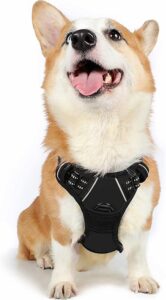
Rabbitgoo is a brand I’ve heard a lot about but hadn’t personally bought from until more recently. I just got this harness to replace my Shiba Inu’s old one she outgrew. They have loads of color options, which was nice, and are great for the price. I only wish they came in extra small (xs), but they do com in small. So if your puppy outgrows their first harness I recommend you pick up this no-pull harness.
Best Front And Back Attaching Harness – RUFFWEAR
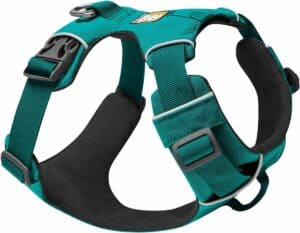
Ruffware is known for their durable and long-lasting products, and their dog harnesses continue that trent. I leard about these from a friend right after grabbing a replacement harness from Rabbitgoo and have been nothing but impressed. My favorite part is the fact they give you the option to attach your Shiba’s leash on either the front and the back, allowing you flexibility when you need it. They even have small and extra small options available, I really wish I found these sooner.
The Best Harnesses For Shiba Inu Puppies
Best Front Attaching Puppy Harness – PoyPet
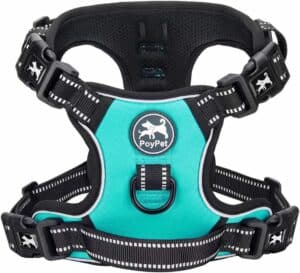
Poypet was the brand I got my first harness from. It’s durable and comes with loads of different straps to adjust, allowing you to tailor the fit to your Shiba. Which was a massive help in preventing mine from slipping out and running away, like she did on her first collar. It also has small and medium sizes for when your puppy outgrows their first harness.
Best Back Attaching Puppy Harness – ThinkPet
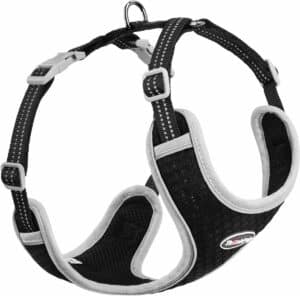
This rear-attaching reflective harness is an excellent starting point for your you and your Shiba. It’s lightweight, breathable, and reflective helping you keep track of your Shiba Inu puppy even in the dark. There are even small and medium options for when you’re Shiba outgrows their first one.
Summary Of How To Pick The Best Harness
Picking the right harnesses, like many purchasing decisions for my Shiba, was a difficult choice to make. Durability along with flexibility are my primary focus, helping me adjust to my Shiba’s mood instead of forcing her into something.
I’ve fround front attaching no pull harness are the best for this breed as a whole. While they can be a pain at first, they are well worth it in the long run. Helping me manage my Shiba’s constant leash pulling, especially when leaves are blowing in the wind.
I recommended you take an extra moment and measure your pet if you have a soft tape measurer laying around. I had a hard time finding ones that fit when my Shiba Inu was a puppy and opted to go back to a collar until I found something that worked. Ruffware’s is definitely a standout option for me, especially since they have extra small and small options available.
Frequently Asked Questions
Is It Okay To Leave My Dog’s Harness On?
A dog can safely wear a harness for up to 3 hours as long as it’s being used, preferably for a walk or training. That time limit can be adjusted for camping trips and hikes, but wearing a harness for prolonged periods of time can lead to skin irritation or become a choking hazard if they’re crated.
What Kind Of Harness Is Best For Shiba Inu?
Front-attaching harnesses are highly recommended for Shiba Inu owners because they prevent choking while minimizing your pet’s ability to tug and pull on their leash. These no pull harnesses achieve this by turn your pet around, back towards you, instead of allowing them to take the lead.
What Harness Is Best For Shiba Inu?
No pull front attaching harnesses are the best for Shiba Inus. They minimize leash pulling by turing your pet to the side, instad of allowing them to tug and pull, while also helping you maintain control over their direction. Redirecting them back to you instead of where they want to go.
